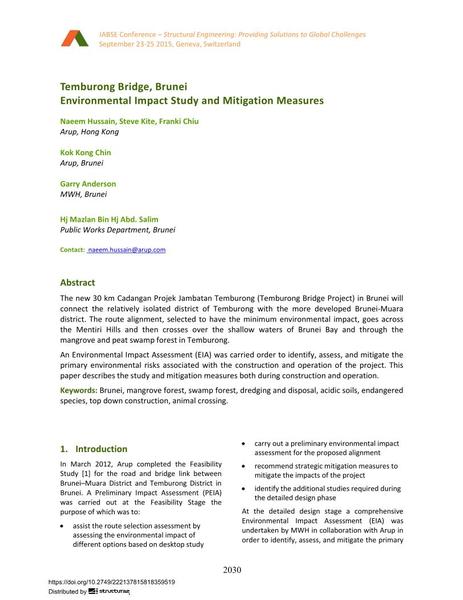Temburong Bridge, Brunei – Environmental Impact Study and Mitigation Measures

|
|
|||||||||||
Détails bibliographiques
| Auteur(s): |
Steve Kite
(Arup, Hong Kong)
Naeem Hussain (Arup, Hong Kong) Franki Chiu (Arup, Hong Kong) Garry Anderson (MWH, Brunei) Hj Mazlan Salim (Public Works Department, Brunei) Kok Kong Chin (Arup, Brunei) |
||||
|---|---|---|---|---|---|
| Médium: | papier de conférence | ||||
| Langue(s): | anglais | ||||
| Conférence: | IABSE Conference: Structural Engineering: Providing Solutions to Global Challenges, Geneva, Switzerland, September 2015 | ||||
| Publié dans: | IABSE Conference Geneva 2015 | ||||
|
|||||
| Page(s): | 2030-2037 | ||||
| Nombre total de pages (du PDF): | 8 | ||||
| Année: | 2015 | ||||
| DOI: | 10.2749/222137815818359519 | ||||
| Abstrait: |
The new 30 km Cadangan Projek Jambatan Temburong (Temburong Bridge Project) in Brunei will connect the relatively isolated district of Temburong with the more developed Brunei-Muara district. The route alignment, selected to have the minimum environmental impact, goes across the Mentiri Hills and then crosses over the shallow waters of Brunei Bay and through the mangrove and peat swamp forest in Temburong. An Environmental Impact Assessment (EIA) was carried order to identify, assess, and mitigate the primary environmental risks associated with the construction and operation of the project. This paper describes the study and mitigation measures both during construction and operation. |
||||
| Mots-clé: |
forêt de mangrove forêt marécageuse sol acide
|
||||
